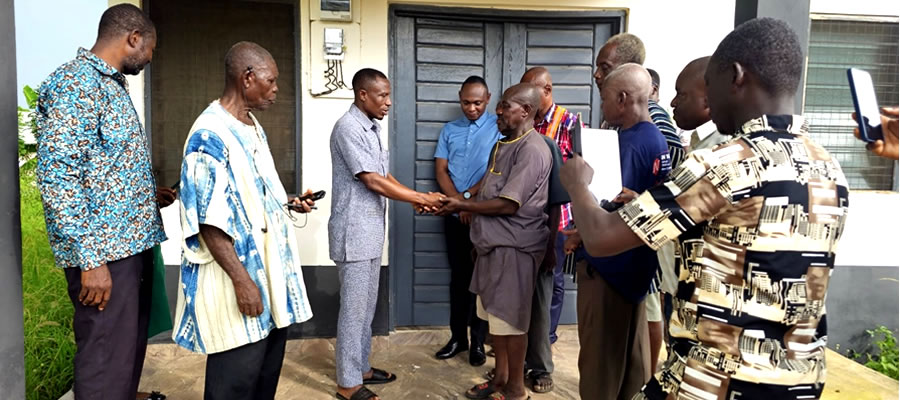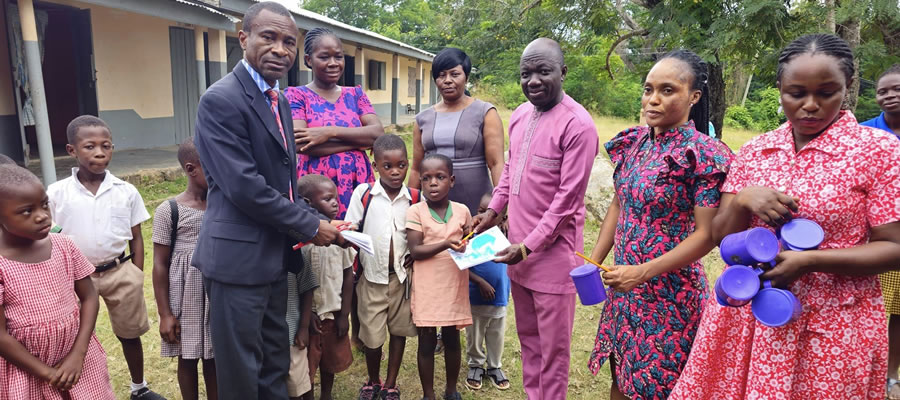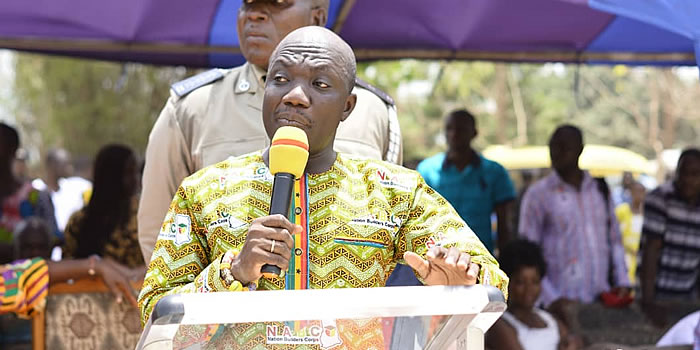

Location
The North Dayi District is located in the Volta Region of Ghana and it is one of the newly created in the country established by LI 2076 of 2012. Its capital is Anfoega and it’s about 70 km from Ho, the Regional capital and 250Km from Accra. The district lies within latitudes 60 20’N and 70 05’N, and Longitude 00 17’E.
The North Dayi District Assembly shares boundaries with Kpando Municipal to the north, South Dayi District to the south, and the newly created Afadzato South District to the east. The Volta Lake which stretches over 80km of the coastal line, demarcates the western boundary. The district covers a total land area of 462.8square kilometers representing 2.2% of the Volta Region with almost 30% of the land being submerged by the Volta Lake. The district is rural and has over sixty (60) settlements. Other relatively larger settlements include Vakpo, Aveme, Awate, and Wusuta. The location of the district is of a very strategic importance for maximizing its potentials for fast economic development.
Figure 1.2: showing map of North Dayi District.
NORTH DAYI DISTRICT MEDIUM-TERM DEVELOPMENT PLAN (2018-2021)
Climate
The district falls within the tropical equatorial zone, and it is generally influenced by the South West Monsoons wind from the South Atlantic Ocean and the dry Harmattan winds from the Sahara. The district is characterized by double-maximum rainfall with average annual rainfall ranging from 900mm to 1,300mm. The double maxima rainfall pattern experienced in the district encourages crop production throughout the year and ensures food security as well as regular income of farmers. It is an opportunity for the farmers to increase their income annually as a result of the two cropping seasons unlike other areas in the country with single season rainfall.
For some years now, the district has not had any significant improvement in the rainfall situation. The major raining season occurs from mid-April to early July and the minor from September to November. The district normally experience considerable variations with the time of the onset of the rains, duration and intensity during the years. This condition affects agricultural activities and resource mobilization for effective investment planning.
The mean annual temperature is about 270 Celsius, where as the daily means ranges from, 220 to 330 Celsius. The months of February and March are generally the hottest while July and August are the relatively cooler. The average relative humidity is 80%. Even though the climatic condition of the district may predispose it to high rate of malaria and diarrhea, the average temperature equally absolve the district from the incidence of Cerebra-Spinal –Meningitis (CSM) diseases.
Vegetation
The district is largely within the semi-deciduous forest vegetation zone. However extensive human activities (including farming, logging and charcoal burning) have reduced the vegetation to secondary and savanna. The deterioration of the vegetative cover was confirmed by all the Area Councils during the data collection and discussions. It is certain that the district was densely forested in former times. But huge forest areas have been destroyed and converted to other land uses during the past decades.
The vegetation of the district is characterized by a mix of guinea savannah woodland and semideciduous forest. The savannah woodlands consist of grass with scattered trees like acacia, bamboo and baobabs. These dots the River Dayi Basin. The semi-deciduous forests are found on the slopes of the Akwapim –Togo –Attakora ranges with many tree species which are also found in high forest zone, such as Antiaris toxicaria chechen, milicia excels (Odum) and Oil palm. Much of the forest has however been lost to inappropriate farming practices, excessive lumbering and bush fires.
Additionally, there is a lot of indirect damage caused by forest fires such as loss of organic material, loss of soil fertility and increase in erosion. All this damages have detrimental effects on other spheres of life such as agriculture pasture and water supply. To conserve the environment and protect the vegetative cover, the Forestry Commission under the FORUM project developed some forest reserves in the district. These are the Awate and Tsrukpe forest reserves. There are other smaller reserves at Wusuta, Aveme Sabadu Vakpo Botoku and Tsoxor. The vegetation of the district is conducive for animal husbandry, cultivation of root cereal crops and horticulture.
Drainage
The Volta Lake and the River Dayi are the major water bodies that drain the district. There are however, other numerous streams and rivulets that are found throughout the district. These rivers and streams are more or less perennial.
The Volta Lake is the biggest water body in the district. It runs along the whole of the western corridor with big potential for irrigation agriculture, aqua-culture and fishing. The River Dayi is another water body to the south and its basin provides a prime farming land for the cultivation of a variety of food crop and vegetables. The presence of these water bodies is a great potential for supporting economic activities which can generate employment opportunities for the youth.
The Volta Lake apart from the agricultural purposes is also a big potential for designing water supply scheme and also as the base for tourism development in the district.
Topography
The most conspicuous physical features of the district are the Akwapim-Togo-Atakora ranges which is at the eastern corridor between Ho and Kpando Districts. The district is dotted with scattered hills and ranges of varied length and height resulting in an undulating feature of the district. The major hills are at Anfoega, Awate, Botoku and Wusuta. The highest point in the district is about 1,250 ft and is located along the Volta Lake around Awate and Botoku. The hilly nature of the district generally affects the condition of the road and therefore results in increase in the cost of construction. The fact that most of the roads are not tarred increase the degree of erosion that seriously affect the condition of these roads and residential buildings during raining seasons. This implies that during this time the cost of transportation for the people along the affected roads increases putting untold hardship to the already impoverished communities.
Not only does the topography affect the condition of the road but also the agricultural productivity of the area. Again the hilly nature of most places throughout the district deny the people access to cultivable land and also impedes large scale mechanized farming. The end result is small land holding which result to subsistence farming with low income.
Geology and Minerals
The district is generally underlain by Buem Volcanic rocks stretching through to Jasikan and Kadjebi District. The implication of this type of rock is that it supports surface supplies of underground water and the surface supplies are fairly good while prospects for boreholes ranges from fair to good. The major soil types developed from this parent rock in the district are the Savannah Ochrosols (reddish, lightly acid; more nutrient) “Oxysol” (heavily drained; yellowish; less nutrient and ground water laterites. This is characterized by sandy loam type of soil with local adaptation. Along the lake and the River Dayi, the alluvial silt loams predominate. The terrain is mostly steep and sometimes gentle resulting in difficulty to access. Inventories made to classify soils according to their general and chemical characteristics indicate that the soils in the district are of low fertility and low moisture holding capacity which has serious implication for agricultural crop development. T
The district is relatively endowed with limited mineral deposits of economic importance. Unfortunately, the district lacks the technology and resources for exploitation and processing. There are large deposits of Kaolin at Anfoega Agatanyigbe, Anfoega Bume and Botoku with different colour stations suitable for the development of bricks and tile, pottery and ceramics industry. This when fully exploited and developed is expected to generate employment for the youth in the district.
BIODIVERSITY, CLIMATE CHANGE AND GREEN ECONOMY
The effects of climate change and its vulnerability can be felt across the length and breadth of the District due to its agrarian nature.
North Dayi District is home to four (4) forest reserves (Dayi Block forest reserve, West Block forest reserve and others) endowed with several economic, fruit and others which serves as home to hundreds and thousands of animals. Not to talk about these forests serving as shade to the numerous springs, streams and rivers that crisscross the length and breadth of the District.
North Dayi District has witnessed a persistent increase in reduction of the forest and other resources including water quality and aquatic life.
The District is experiencing a destruction of its ecosystem and natural resource base through the under listed factors;
• Destruction of forests through encroachment into forest reserves and exploitation of economic timber species without permit
• Annual bush fires
• Inappropriate farming practices and deforestation, destruction of vegetation and the ecological systems through cultivation on slopes and on the lands adjoining rivers and streams
• Encroachment into and destruction of wildlife sanctuary through uncontrolled hunting and other human activities
• Winning of sand, quarrying of stones and gravel for building and road construction
• Lack of enough education on the negative effects climate change
• Accelerated erosion resulting from removal of vegetative cover around dwellings and open spaces in settlements and absence of properly constructed drainage channels
• Non-management of domestic waste i.e. rubbish and human excreta are disposed-off indiscriminately
• Little monitoring of the environmental impact of human activities and development projects
The Assembly with support from development partners will implement interventions to mitigate the impacts of this trends in the District.
WATER SECURITY
Provision of water facilities to the District is by GoG, Safe Water Network, GWCL, CWSA and UNICEF. Coverage of portable water in the District stands at 87% in 2015 against the projected 2018 population of 48, 382 inhabitants which makes it one of the highest in the region and beyond.
Safe Water Network augments the supply of water to four communities within the district (Aveme, Sabadu, Agata, Agatanyigbe and Vakpo). The District through CWSA has seven (7) small town/pipe systems serving communities like, Anfoega, Vakpo, Wusuta, Tsrukpe etc with additional four (4) small community pipe schemes to these same communities.
There is a total number of sixteen (16) pipe schemes and five (5) limited mechanized boreholes and 142 boreholes fitted with hand pumps. Other sources of water is mainly from the Lake Volta and River Dayi serving inhabitants without access to safe water coverage. Figure 1.3 below shows community water facilities in the District.
Figure 1.3: Showing water map of North Dayi District.
NATURAL AND MAN-MADE DISASTERS
A disaster is a serious distraction occurring over a relatively short time of the functioning of a community or a society involving wide spread human, material, economic or environmental loss and impacts which normally exceeds the ability of the affected community or society to cope using its own resources.
The North Dayi District is prone to both natural and man-made disasters, ranging from Boat Transport incidents, Meteorological disasters, Disease and Epidemic Outbreaks, Domestic and Bush Fires, Pest and Infestation of Farms and Crops, Natural Resource destruction activities like deforestation, pollution of water bodies etc.
General disaster occurrences records of the North Dayi District during the period under review totaled 34 officially reported disasters comprising Lake and Road Transport, Rainstorm, Domestic and Bush Fires, Flooding of 93 acres of farm. 177 people were displaced by rainstorm whiles 8 death tolls were recorded by lake and road transport.
Excluding the above were other incidents or menaces such as Road Transport incidents relating to “Okada” Transport Service providers with 200 reported accident cases with varied degrees of casualties in only one health facility not to talk of other health facilities and unreported cases.
Other menaces were pest and insect infestation with regard to Black Flies across the entire district particularly in communities like Wusuta, Sabadu, Aveme, Tsorxor, Vakpo, Awate etc. located along the Volta Lake and River Dayi and tributaries/channels and also Armyworm invasion.
Managing the menace, currently is an on-going public education on protective clothing and use of repellents in collaboration with Ghana Health Service to produce some drugs for administration in the affected communities.
With regard to the Armyworm management, spraying of farms by the Ministry of Food and Agriculture and efforts to produce additional chemicals in readiness to combat the menace should it re-emerge. Road transport incidents drawn safety programmes are far advance to reverse the negative trend.
Floods:
Flooding as a natural disaster is not very prevalent in the District. There was only one occurrence in 2017 displacing 41 victims as a result made up of 18 males and 23 females. The District is however ready to mitigate any human activity that might result in this hazard.
Bushfires:
Bushfire is very rampant in the District due to its agrarian nature and the over dependence on wood fuel. Human and biological activities are the main factors contributing to the high rate of bush burning which destroys biodiversity and increase climate change and its negative impacts on the Environment, ecology and the eco-system. Three (3) incidence of bush burning was recorded in 2017 with eight affected victims (8) made up of three males and five females.
Rain storms:
It is mostly experienced during rainy season with 15 incidence recorded between 2015 and 2017 displacing 245 victims made up of 100 males and 145 females.
Boat Disaster: Due to lake transport along the Volta Lake and Dayi River, boat incidence is relatively high. Between 2015 and 2017, three (3) incidence of lake transport was recorded with 31 victims made up of 11 males and 20 females.
Epidemics:
There are no significant outbreak of contagious diseases apart from incidence of cholera and malaria cases within the District due to indiscriminate disposal of sewage in our environment.
Air and Water Pollution:
Air and water pollution is not a major issue within the District. This is due to the fact that, activities such as sand winning and mining is relatively low in the District. But bush burning, smokes from exhaust fumes and combustion remains the major proponent causing pollution. Major water bodies are also being polluted due to indiscriminate and excessive use of agro. Chemicals along river banks.
Climate change:
Issues of climate change remains a big concern within the District as activities both human and biological are significant factors which may contribute to hazards.
Land degradation:
Land degradation is mainly caused by poor agricultural practices, deafforestation, desertification, erosion among others within the District.
NATURAL RESOURCE UTILIZATION
The natural resources available to the district can generally be grouped under forest reserves, arable land, water resources (Lake Volta, River Dayi) and mineral resources. The forest reserve is a local one which is utilized for research purposes, recreation and also serves as a tourist site.
The arable land (fertile lands) are basically used for farming activities and sustainable farming can be used for the extraction of the resource.
The water resources are mainly the rivers in the district and the lake volta. They are used for irrigation, fishing and as a tourist site. Again sustainable fishing activities are the technologies that can be used for their extraction.
The mineral resource is mainly white clay which is basically chewed by women in the district. The available technology for its extraction is the use of hoes. Mechanized sustainable extraction can be another technology for its extraction and in order to enhance its utilization, it can be used for paints, ceramics and tiles.
Support for Effective Use of Natural Resource
The measures put in place to ensure the effective utilization and sustainability of the fertile lands include the education of farmers by agricultural extension officers and through the local and assembly bye-laws. For the forest reserves and the water resources, again the local and assembly bye laws protect them from illegal activities.
Challenges for the Use of Natural Resource
The listed challenges as faced by the district with respect to their natural resources include; the unapproved usage of agro-chemicals for farming, the activities of illegal chain saw operators in the reserves, the use of unapproved fishing methods and the difficulty in finding other uses for the white clay.
Date Created : 11/23/2017 5:45:40 AM












 facebook
facebook
 twitter
twitter
 Youtube
Youtube
 +233 593 831 280
+233 593 831 280 0800 430 430
0800 430 430 GPS: GE-231-4383
GPS: GE-231-4383 info@ghanadistricts.com
info@ghanadistricts.com Box GP1044, Accra, Ghana
Box GP1044, Accra, Ghana